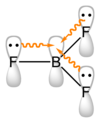Boron trifluoride etherate
|
|
|||
| Names | |||
|---|---|---|---|
| Other names
Boron fluoride, Trifluoroborane
|
|||
| Identifiers | |||
|
7637-07-2 13319-75-0 (dihydrate) |
|||
| 3D model (Jmol) | Interactive image | ||
| ChEBI |
CHEBI:33093 |
||
| ChemSpider |
6116 |
||
| ECHA InfoCard | 100.028.699 | ||
| EC Number | 231-569-5 | ||
| PubChem | 6356 | ||
| RTECS number | ED2275000 | ||
| UNII |
7JGD48PX8P |
||
| UN number | Compressed: 1008. Boron trifluoride dihydrate: 2851. |
||
|
|||
|
|||
| Properties | |||
| BF3 | |||
| Molar mass | 67.82 g/mol (anhydrous) 103.837 g/mol (dihydrate) |
||
| Appearance | colorless gas (anhydrous) colorless liquid (dihydrate) |
||
| Density | 0.00276 g/cm3 (anhydrous gas) 1.64 g/cm3 (dihydrate) |
||
| Melting point | −126.8 °C (−196.2 °F; 146.3 K) | ||
| Boiling point | −100.3 °C (−148.5 °F; 172.8 K) | ||
| exothermic decomposition (anhydrous) very soluble (dihydrate) |
|||
| Solubility | soluble in benzene, toluene, hexane, chloroform and methylene chloride | ||
| Vapor pressure | >50 atm (20°C) | ||
| 0 D | |||
| Thermochemistry | |||
| 50.46 J/mol K | |||
|
Std molar
entropy (S |
254.3 J/mol K | ||
|
Std enthalpy of
formation (ΔfH |
-1137 kJ/mol | ||
|
Gibbs free energy (ΔfG˚)
|
-1120 kJ/mol | ||
| Hazards | |||
| Safety data sheet | ICSC | ||
| GHS pictograms |
  
|
||
| GHS signal word | DANGER | ||
| H330, H314 | |||
|
EU classification (DSD)
|
Very toxic (T+) Corrosive (C) |
||
| R-phrases | R14, R26, R35 | ||
| S-phrases | (S1/2), S9, S26, S28, S36/37/39, S45 | ||
| NFPA 704 | |||
| Flash point | Non-flammable | ||
| Lethal dose or concentration (LD, LC): | |||
|
LC50 (median concentration)
|
1227 ppm (mouse, 2 hr) 39 ppm (guinea pig, 4 hr) 418 ppm (rat, 4 hr) |
||
| US health exposure limits (NIOSH): | |||
|
PEL (Permissible)
|
C 1 ppm (3 mg/m3) | ||
|
REL (Recommended)
|
C 1 ppm (3 mg/m3) | ||
|
IDLH (Immediate danger)
|
25 ppm | ||
| Related compounds | |||
|
Other anions
|
Boron trichloride Boron tribromide Boron triiodide |
||
|
Other cations
|
Aluminium fluoride Gallium(III) fluoride Indium(III) fluoride Thallium(III) fluoride |
||
|
Related compounds
|
Boron monofluoride | ||
|
Except where otherwise noted, data are given for materials in their standard state (at 25 °C [77 °F], 100 kPa).
|
|||
|
|
|||
| Infobox references | |||
Boron trifluoride is the inorganic compound with the formula BF3. This pungent colourless toxic gas forms white fumes in moist air. It is a useful Lewis acid and a versatile building block for other boron compounds.
The geometry of a molecule of BF3 is trigonal planar. Its D3hsymmetry conforms with the prediction of VSEPR theory. The molecule has no dipole moment by virtue of its high symmetry. The molecule is isoelectronic with the carbonate anion, CO32−.
BF3 is commonly referred to as "electron deficient," a description that is reinforced by its exothermic reactivity toward Lewis bases.
In the boron trihalides, BX3, the length of the B-X bonds (1.30 Å) is shorter than would be expected for single bonds, and this shortness may indicate stronger B-X π-bonding in the fluoride. A facile explanation invokes the symmetry-allowed overlap of a p orbital on the boron atom with the in-phase combination of the three similarly oriented p orbitals on fluorine atoms. Others point to the ionic nature of the bonds in BF3.
BF3 is manufactured by the reaction of boron oxides with hydrogen fluoride:
...
Wikipedia




